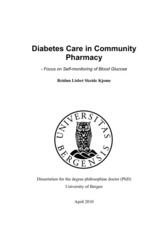Diabetes Care in Community Pharmacy - Focus on Self-monitoring of Blood Glucose
Doctoral thesis

Permanent lenke
https://hdl.handle.net/1956/4351Utgivelsesdato
2010-09-24Metadata
Vis full innførselSamlinger
Sammendrag
Diabetes is a growing concern worldwide. Ideal management of the disease requires extensive self-care and broad follow-up by health care professionals. Considerable research has been done on involving the pharmacist in the healthcare of patients with diabetes, arguing that community pharmacists’ high availability to patients and specialized medication-focused education makes them a valuable asset to the diabetes team. This thesis consists of four papers. The work for these papers was performed from 2004 to 2009. Paper I gives an overview over diabetes care provided by Norwegian pharmacies. It is based on a descriptive study where all Norwegian pharmacies were invited to participate by filling out an online questionnaire. We found that most pharmacists were interested in working diabetes services. Some pharmacies offered diabetes patients a wide range of Services, but quality control of these services was seldom established. Almost all pharmacies offered practical services related to self-monitoring of blood glucose (SMBG), while giving advice on diet and other lifestyle factors was rarely done. The pharmacists were motivated to work within diabetes care, in particular SMBG. In Paper II we demonstrate how one can assure the quality of a point-of-care test (POCT) at the community pharmacy, in our case a blood glucose test, and show that when given the correct follow-up the pharmacies are able to match the quality of the results achieved at general practitioners’ offices. In Paper III we tested a new pharmacy service, where patients brought their own glucometers to the pharmacies where the glucose method was established. Patients had both their performance and their glucometer tested against the pharmacy method. We found that this reduced the number of user errors. It had no effect on the analytical quality of the patients’ SMBG results, which was good throughout the study. The patients’ trust in their own measurements Increased after their visit to the pharmacy, and the patients expressed a wish for annual pharmacy controls. In Paper IV we report the sales of SMBG strips to all non-institutionalized patients in Norway in 2008. We found that 96 999 different patients purchased strips that year. This gave a prevalence of 2 % in the Norwegian population, and approximately 70 % among patients being treated pharmacologically for their diabetes. The mean number of strips per day was 1.7, however 53 % of the patients did not purchase enough strips to monitor their blood glucose daily. The one percent of the patients who bought the most strips was responsible for 8 % of the costs. Most patients used only one brand of glucometer, though three percent purchased from 3-7 different types of strips. Use of strips increased with number of different types of strips. The sum of this work suggests that Norwegian pharmacies can be more actively used in assisting diabetes patients with their SMBG. The employees are motivated, and already involved at a smaller scale. Given correct training and follow-up they are capable of performing services involving POCT of good analytical quality, and patients are happy to receive this type of service from their community pharmacy. A small number of patients use a disproportionate amount of resources spent on SMBG, while a large number of patients rarely perform SMBG, giving room for improvement in the way resources are being spent. Several challenges remain: reaching the patients most in need of SMBG assistance, attaining access for pharmacies to the quality control support from the Norwegian Quality Improvement of Primary Care Laboratories (NOKLUS), and ensuring remuneration for the service.
Består av
Paper I: Pharmacy World and Science 30(2), Kjome, R. L. S.; Sandberg, S.; Granas, A. G., Diabetes care in Norwegian pharmacies: a descriptive study, pp. 191-198. Copyright 2007 Springer Science+Business Media. Full text not available in BORA due to publisher restrictions. The published version is available at: http://dx.doi.org/10.1007/s11096-007-9164-5Paper II: International Journal of Pharmacy Practice 18(1), Kjome, R. L. S.; Nerhus, K.; Sandberg, S., Implementation of a method for glucose measurements in community pharmacies, pp. 13-19. Copyright 2010 The Authors, journal compilation 2010 Royal Pharmaceutical Society of Great Britain. Full text not available in BORA due to publisher restrictions. The published version is available at: http://dx.doi.org/10.1211/ijpp.18.01.0004
Paper III: Pharmacy Practice 8(1), Kjome, R. L. S.; Granas, A. G.; Nerhus, K.; Sandberg, S., Quality assessment of patients’ self-monitoring of blood glucose in community pharmacies, pp. 62-69. Published by Centro de Investigaciones y Publicaciones Farmaceuticas. Reproduced with permission. Published version
Paper IV: Diabetes Technology and Therapeutics 12(9), Kjome, R. L. S.; Granas, A. G.; Nerhus, K.; Roraas, T. H.; Sandberg, S., The prevalence of self-monitoring of blood glucose and costs of glucometer strips in a nationwide cohort, pp. 701-705. Copyright 2010 Mary Ann Liebert. Reproduced with permission. Published version. The published version is available at: http://dx.doi.org/10.1089/dia.2010.0056
Utgiver
The University of BergenOpphavsrett
Copyright the author. All rights reservedThe author